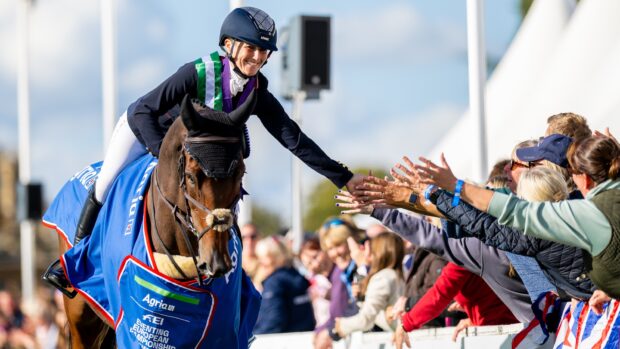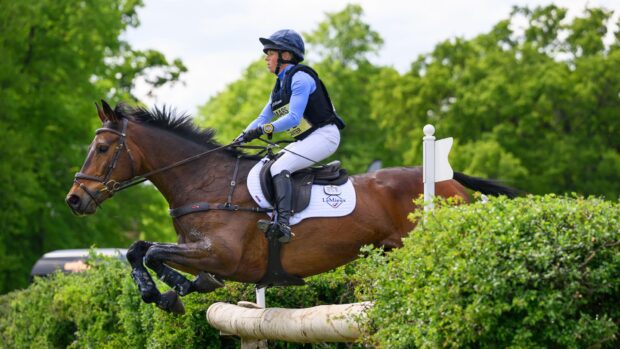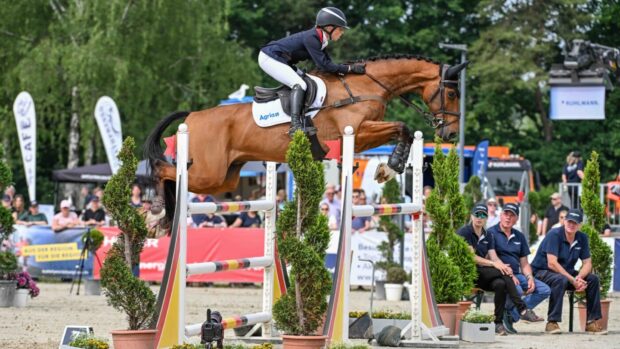The dun gelding took consecutive Badminton titles in the 1950s, and put the “glamour girl” of eventing Sheila Willcox on the map. Madeleine Silver charts his swift – and turbulent – rise to the top as we celebrate Horse & Hound’s 140th anniversary in 2024
Watching High And Mighty thrashing around in merciless sinking sand, Sheila Willcox – who died in 2017 – wondered if she was about to lose the gelding that she’d brought home to Lancashire just a few short months earlier.
Hacking in the country behind the seaside town of Lytham, she had approached a stream which “Chips” had leapt at in an effort to stay dry, resulting in both horse and rider landing in the water. Scrambling out, Sheila turned to see her new mount trying in vain to reach the bank. A breathless dash to a nearby farm followed, and Chips was rescued with a tractor.
As her brother John Willcox said: “Sheila was always good with horses, but I think she had a particularly good bond with High And Mighty – and I would imagine that got a bit stronger when she saved his life.”
It wasn’t the only episode that threatened to derail Chips’ career – which would climax with consecutive Badminton titles in 1957 and 1958, as well as the team and individual medals at the 1957 European Eventing Championships – before it had begun. While temporarily stabled with Blackpool’s beach ponies, he was accidentally mistaken by the knackerman for a pony that needed to be destroyed, being saved in the nick of time by a stable hand.
“But for this lucky intervention Chips would have been fed to the lions in Blackpool Tower circus,” Sheila wrote in her autobiography Three Days Running. Even his arrival with Sheila in 1954 wasn’t plain sailing. The train journey north from his former home in Sussex resulted in an ongoing cough, and Sheila wondered “whether I should actually have him for very much longer”. At the pair’s first hunter trials together in the spring of that year, Chips wouldn’t canter to the first alone, his experience of jumping at that point confined to the hunting field.
“Had anyone told me then that these dreams would come true, I would just have laughed,” she reminisced.
When Sheila put a “wanted” advert in Horse & Hound on returning from travelling as a nearly-18-year-old, she was inundated with offers of horses that promised to be future eventing stars.
But it wasn’t until a Mrs Lake replied with a picture of a dun seven-year-old by a thoroughbred and out of a part-bred Arab – who had been bred in Ireland and hunted with the Meath – that she was taken. Sheila didn’t deem Chips beautiful, with the dark eel stripe running down his back a nod to his Highland pony grand-dam. But when he stepped off the train in February 1954, she immediately took a shine to him.
“The mixture of breed did not worry me in the slightest, for I believe a splash of common blood does no horse any harm,” she said.

Sheila Willcox and High and Mighty at Badminton
After a childhood on ponies and in the show ring, the famously dogged Sheila came to eventing by way of elimination; finding another horse to equal her champion hack Blithe Spirit seemed unlikely and showjumping was out of the question (“My mother was totally opposed to the idea of her daughter joining the ranks of those she clearly thought to be a threat to my virginity,” she wrote).
Having never been to a horse trials, she approached her new sport with the ruthless discipline and determination that came to define her career.
Later she’d be accused of taking short cuts on the roads and tracks (“my competitive spirit could never be quelled”) and as her ex-husband John Waddington once said: “She could be so very kind but if you got in the way of her winning, God help you!”
It was at her first horse trials as a spectator that Sheila overhead a competitor detailing their fitness plan, gradually working up to one-and-half hour’s road exercise daily before a one-day trial. And ahead of her first event as a competitor at Hovingham Hall in Yorkshire, she set about replicating the plan with clinical precision for Chips, compensating for Lytham’s flat terrain with extra work.
Chips was naturally well balanced with free-moving paces, but Henry Wynmalen’s book Dressage was deployed to assist that phase. The work paid off. Her first foray into the sport ended in victory, and by the end of that first season in 1954 Sheila and Chips were crowned associate champions at the Pony Club Championships.
The beach at home in Lancashire became Sheila and Chips’ schooling ground, jumping the jetty where fishermen would trundle carts of nets, as well as the boats dotted out of reach of the tide.
By the start of the 1955 spring season, Chips was on four feeds a day, including carrots and brown sugar, and his true, lively demeanour was beginning to show. He’d wave his foreleg in the air while being groomed, pull faces when anyone dared enter his box and was prone to undoing his rope, forcing Sheila to leap out of the way of his teeth.
“If ever his teeth did make contact, no one was more surprised than Chips himself,” she wrote. “I even encouraged him in his wickedness, for he was careful with me and so I felt no compunction about it. It all contributed to his becoming a ‘one man’ horse, and this prospect delighted me.”
When the pair were selected to represent Britain at the Turin International that year, Sheila was the only woman in the competition. It was a reminder of the patriarchal sporting arena she had entered – but also gave her the first taste of international success as she took to the podium.
“The full extent of the worst of human nature – jealousy and malice – were still a mystery to me,” she said. “I was young, female and the best, and consequently the old men who ruled the sport in those days would jealously guard their province.”
By Badminton 1956, the equestrian world couldn’t ignore this blazing force.
“She was a genius in her own way,” says Olympian Michael Bullen, a fellow competitor of the same era. “She very rarely took a fall, always rode fast and rarely slowed down – she might just steady with one hand but that was it. It didn’t matter what the fence was; she just rode straight into them.”
Having gone into the lead after her dressage at Badminton, Sheila was overtaken by reigning European Champion Frank Weldon and Kilbarry by just 1.56 penalties, and with both riders finishing on their dressage score, Frank triumphed. A fierce rivalry ensued between the two riders, “fuelled perhaps by a frisson of chauvinism, snobbery and latent and unrequited lust,” suggests the author of the Little Book of Badminton, Julian Seaman.

Sheila Willcox riding High And Mighty, watched by Major John Birtwistle on Delagyle and Virginia Gilligan on Jungle Queen, with Colonel Harry Weldon at Windsor Three-Day Event in September 1955.
Two weeks before Badminton the following year, Kilbarry broke his neck and was killed at Cottesbrooke, launching Sheila and Chips into the spotlight as favourites for the 1957 title – and denying them the chance of a return duel.
Sheila had taken the lead after cross-country, after which her 21st birthday celebrations got under way. A cake, complete with undulating terrain, 21 fences and a model of Chips and her leaping safely over the last fence was presented to her, and by 3am she was still trying to shoo away the final revellers.
“I could hardly keep upright,” she recalled.
But by the next day, her gamesmanship had returned and she was riding Chips into a practice fence on a deliberately wrong stride to sharpen him up. Collecting the trophy from The Queen later that day, she became only the second woman to win Badminton; the first having been Margaret Hough, who had taken Sheila and Chips to their first one-day-event at Hovingham just 18 months earlier.
Selection for the European Eventing Championships in Copenhagen followed and the pair’s signature “flat out” cross-country round helped bump Britain into second place after that phase, before securing individual and team victory on the final day in torrential rain. A garland of carrots was presented to Chips, and at the celebratory banquet that evening a toast was made to “the horse, and a particular horse – High And Mighty”.
By the time the golden duo of eventing entered the showjumping arena at Badminton in 1958 the pressure had mounted.
“Although High And Mighty could have walked lightheartedly through five of the 12 obstacles and still been the victor, something special is always expected of him,” it was reported in Country Life.
Her second victory here, this time with a 47-penalty lead (there would be a record third consecutive triumph in 1959 on Airs And Graces) intensified the debate about female eventers competing at the Olympics, while Sheila fielded mounting demands for dressage displays, books signings and appearances on programmes like the BBC’s Woman’s Hour.
“Without wanting to appear a militant feminist, I still think the element of danger is in ratio to intelligent riding, and that should an unlucky accident happen to a woman instead of a man, she will show equal fortitude and endurance, as well as possibly less sustained shock due to the relief of feminine tears,” she wrote.
But despite her unrelenting success, the Olympic committee’s stance didn’t waver – it was not until 1964 that a female eventer competed at the Games – and Sheila decided to stop competing Chips at his peak. Her dreams of winning Olympic gold on him might have vanished, but the pair had paved the way for Britain’s flurry of female riders to follow.
Chips had won all the prizes open to him, and “no horse would ever again give me as much pleasure and success,” Sheila said.
“Chips was my one true love”
When Sheila was approached by a member of the Olympic select committee at Badminton in 1956 to say that Chips was wanted for the Stockholm Olympics for Michael Naylor-Leyland to ride, she was horrified.
“I was shattered […] Chips needed a certain type of riding and a love and understanding that no man would be capable of giving him,” she wrote.
It took an equerry to The Queen – asking on behalf of Her Majesty for her to lend or sell Chips for the Olympics – to persuade Sheila and her parents that there was no other option.
“I felt as if my heart was breaking. I knew that I would never have another Chips. He was my one true love,” she said.
Fellow eventer and British selector Ted Marsh bought Chips for the team for £5,000, but Sheila’s heartache was short-lived; while training at the Royal Mews in Windsor, Chips went lame and so never went to Stockholm and she was able to buy him back. She later speculated that it was in fact a “gross misunderstanding between horse and rider” rather than lameness that scuppered Chips’ Olympic chances.
The incident marked the start of her passionate affair with Ted, who was 25 years her senior and married. In comparison to him, the young men that her mother paraded in front of her seemed boring and “clumsy in their attempts at seduction”. By the time of Chips’ retirement, Sheila was engaged to John Waddington (a marriage that would last only a few years), and she offered Chips to Ted to hunt with the Heythrop, which served as a way of keeping in touch with her former lover.
You might also enjoy reading…

Legends of the sport: The eventing career of Princess Anne

Legends of the sport: The golden eventing career of Jane Holderness-Roddam *H&H Plus*
The rider who captured hearts as “the galloping nurse” and was the first woman ever to ride on a British

Legends of the sport: Showjumper Marion Mould with her pony Stroller *H&H Plus*
The teenage girl on a pony that conquered the world stage has become the stuff of showjumping legend. Penny Richardson

Horse & Hound’s 140th anniversary legends: Milton – John Whitaker’s wonder horse who won over £1m during his career

Legends of the sport: Happy 70th birthday to six-time Badminton winner Lucinda Green

Subscribe to Horse & Hound magazine today – and enjoy unlimited website access all year round
Horse & Hound magazine, out every Thursday, is packed with all the latest news and reports, as well as interviews, specials, nostalgia, vet and training advice. Find how you can enjoy the magazine delivered to your door every week, plus options to upgrade your subscription to access our online service that brings you breaking news and reports as well as other benefits.



